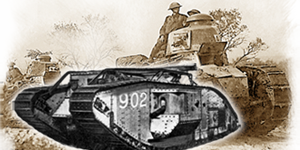Minerva
 Armored car (1914)
Armored car (1914)Belgium - approx. 35 built
The Belgian Army, pioneering the use of armored cars

By 1914, the good road network and flat terrain of Belgium favored large-scale use of armored cars. In 1912 the Belgian Army was already pioneering small patrol units of regular road cars equipped with machine-guns. In August 1914 two were taken in hand by Lt. Henkart to be armored and then donated back to the Belgian Army. The most well known of these vehicles was the Minerva, built at Antwerp. This 16CV sturdy and powerful car design was shipped "naked" (without bodywork) to Cockerill works, located in Hoboken, and equipped with 4mm (0.15 in) armored plates.
Design of the Minerva

To cope with the extra weight, double wheels were added to the rear drivetrain. For better rigidity, there were no doors, the crew having to climb into the vehicle. The single open-top superstructure (also called "bathtub") housed the driver, commander, gunner and gun servant (although the crew could be from three to six including sharpshooters). The superstructure was flat at the front and rounded at the end, whilst the ring mount for the machine-gun was placed at the rear and allowed it to traverse fully. The machine-gun, a standard air-cooled 8mm Hotchkiss model 1912 or 1914, was protected by a shield. The engine hatch was armored, as well as the radiator, by a small twin hatch.
Evolution and wartime action

Around thirty Minerva were converted as armored cars in 1914, before the factory was captured during the German advance; by 1916, the design was completely revised. The open-top was fully enclosed, the machine gun now relocated aft under an armored cupola and two side doors added. At least one was equipped with a Puteaux 37mm gun, however it is not know how many of this version were made.

They were used in small three-cars platoons of the motorized cavalry units, chiefly for reconnaissance, fire support for infantry and long missions behind the German lines. It seemed their off-road capabilities were rather limited. The Germans captured four model 1914, and modified them. They were used during the invasion of Romania, and at least one was used in Berlin during the 1919 events. Others were transferred to the Russians and fought briefly in 1917. Their robust capabilities allowed some of them to remain in service until 1933-35 with gendarmerie units.

Minerva specifications |
|
| Dimensions | 4,90x1,75x2,3 m (16.1x5.9x7.6 ft) |
| Total weight, battle ready | 4 tons |
| Crew | 3-6 |
| Propulsion | 4-cyl Gas. Minerva 8L, 40bhp at 2500 rpm |
| Speed | 40 km/h (25 mph) |
| Range | 150 km (90 mi) |
| Armament | 1 x Hotchkiss Model 1909 machine-gun |
| Armour | Maximum 4 mm (0.15 in) |
| Total production | 35 |

The Great War
 Austria-Hungary
Austria-Hungary Belgium
Belgium British Empire
British Empire France
France German Empire
German Empire Italy
Italy Russia
Russia USA
USAWW1 tanks posters







